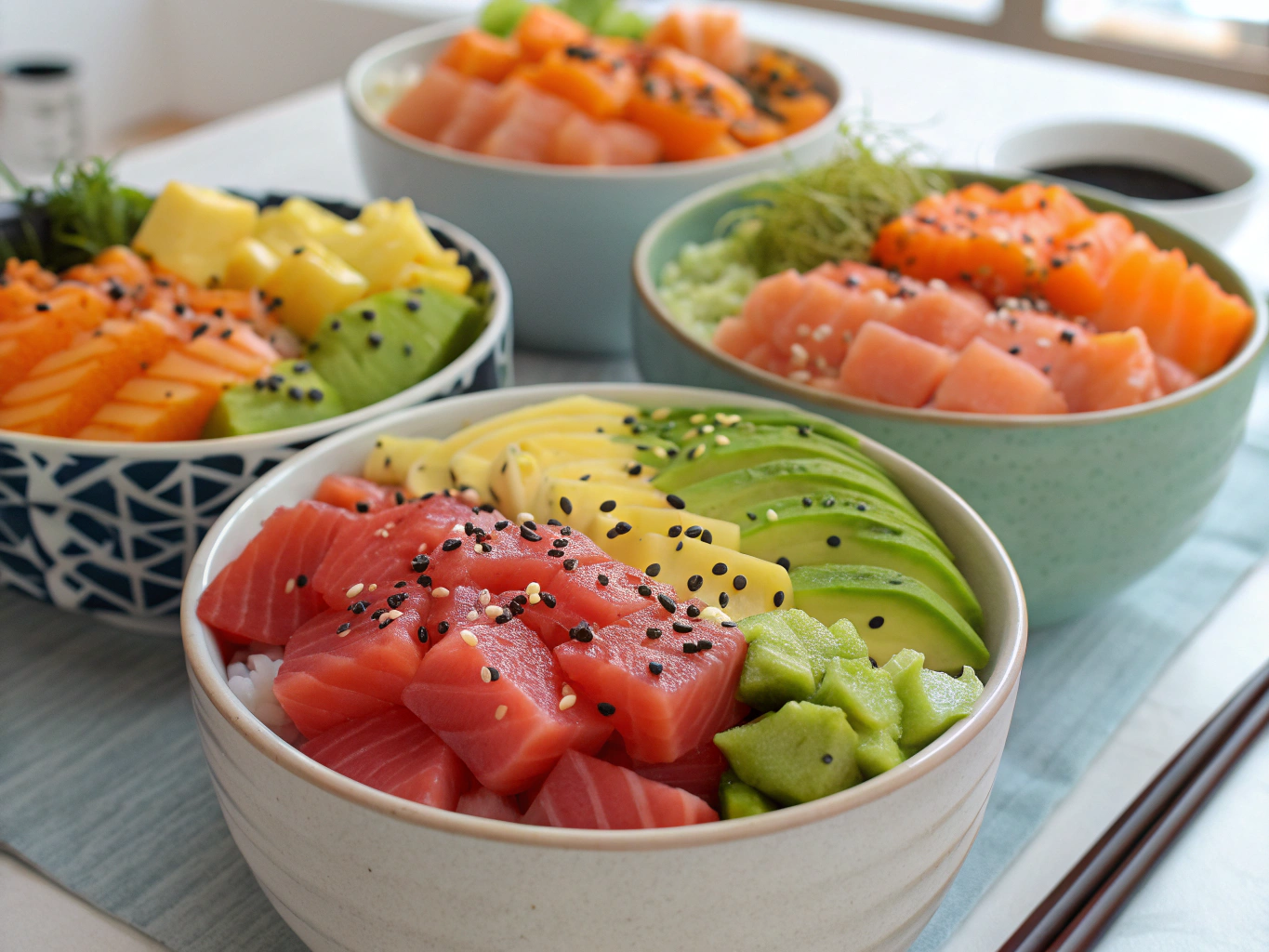
Sushi bowls are the perfect answer when you’re craving sushi but don’t want to invest time into rolling it up. This article covers everything you need to build exciting and customizable sushi bowls at home—without special tools or rare ingredients. We’ll explore how to combine traditional flavors with modern creativity using simple tips, nutritious ingredients, and time-saving techniques. Whether you’re brand new to sushi-style meals or a seasoned sushi lover wanting a flavorful shortcut, you’re about to discover how easy, fast, and fun these bowls can be.
My Journey to Sushi Bowl Bliss
From a Charleston Kitchen to Flavor-Filled Bowls
I still remember the first time my grandmother let me assemble a meal on my own—no rules, no recipes. That’s when I learned food is about feel, not formulas. Years later, after cooking through potlucks and food trucks, I found myself craving sushi, but I didn’t have a rolling mat—or the patience to make traditional rolls. So I built a bowl instead. That night, surrounded by friends who scraped their bowls clean, I knew I had something special. These sushi bowls have become a household favorite, beloved for their speed, flavor, and customization.
Why Sushi Bowls Work for Everyone
Sushi bowls aren’t just trendy; they’re practical, nourishing, and endlessly adaptable. Whether you follow a plant-based diet, love seafood, or are somewhere in between, sushi bowls let you mix and match fresh vegetables, protein, and grains in satisfying ways. Unlike traditional sushi, there’s no technique barrier. Just prep, layer, and enjoy. And if you’re someone who shops at your local farmers’ market or loves refreshing weekday meals—these bowls will fit right into your rotation.
For more comforting classics turned modern, like these plant-based lentil sloppy joes, or twists like vegan enchiladas, you’ll love how sushi bowls bring flavor and flexibility to the table.
How to Make Sushi Bowls at Home
Ingredients That Inspire Customization
You don’t need fancy sushi-grade fish or imported sauces to make a great sushi bowl. The beauty lies in layering textures and flavors that pop. Here’s a basic lineup with plenty of room to make it your own.
| Ingredient | Options & Substitutions |
|---|---|
| Base | Sushi rice (classic), brown rice, or quinoa for extra protein |
| Protein | Veg: marinated tofu, edamame | Seafood: cooked shrimp, tuna, crab |
| Veggies | Cucumber, avocado, carrots, radish, roasted sweet potato |
| Toppings | Pickled ginger, seaweed, sesame seeds, green onions |
| Sauce | Soy sauce, spicy mayo, tamari, or ponzu |
For plant-based inspiration, use crispy tofu stir-fry techniques to ensure your bowl has both crunch and flavor.
Timing It Right
You can prep a complete sushi bowl in under 30 minutes—perfect for weeknights. That’s 20–30% faster than making sushi rolls while still capturing the bold, fresh flavors. Here’s a basic time breakdown:
- Prep time: 15–20 minutes (includes chopping veggies, cooking rice, and prepping protein)
- Assembly: 10 minutes
- Total: 25–30 minutes
Multitasking tips: Start cooking your rice first and chop all vegetables while it simmers. If you’re baking tofu or sweet potato, pop that in the oven during rice prep.
Step-by-Step Sushi Bowl Guide
- Cook your rice: Rinse 1 cup of sushi or short-grain brown rice. Cook as per package instructions (usually around 18–20 minutes). Once done, mix in 1 tbsp rice vinegar, 1 tsp sugar, and ½ tsp salt for that signature sushi flavor.
- Prep your protein: If you’re using tofu, press it for 10 minutes and cube it. Bake at 400°F for about 20 minutes with a soy-maple marinade. Cook shrimp or use canned light tuna with a sesame oil drizzle.
- Slice your vegetables: Go for thin matchsticks or bite-sized pieces. Keep colors varied and textures mixed for the best eating experience.
- Assemble the base: Scoop rice into bowls and top with your proteins, veggies, and sauce.
- Garnish: Sprinkle sesame seeds, lay seaweed strips, and drizzle extra dressing or spicy mayo.
To create creamy sauces, blend vegan mayo with fresh herbs or sriracha—it adds a big punch with little effort.
Nutrition and Benefits of Sushi Bowls
Are Sushi Bowls Good for You?
Absolutely. By deconstructing traditional sushi, sushi bowls retain all the nutrition—fiber-rich grains, lean proteins, and antioxidant-loaded veggies—without excessive sodium or tempura. Consider these stats for a basic bowl using tofu:
- Calories: 450–550
- Protein: 15–20g
- Fiber: 8–10g
- Healthy fats: Provided by avocado and sesame
Read more about healthy seafood and soy intake from this FDA expert guideline on seafood nutrition.
For an even heartier, high-fiber version, swap in roasted chickpeas from this pita recipe for a tasty crunch.
Best Sauces and Seasonings
Your sauce makes or breaks your bowl. While soy sauce is the go-to, there are plenty of other creative drizzle options:
- Spicy mayo: Vegan mayo + sriracha + lime juice
- Tamari & sesame oil: Great gluten-free choice
- Ponzu: Citrus-soy combo with a tang
- Gochujang: Adds heat and umami depth
Pro tip: Toast your sesame seeds in a dry skillet for 1–2 minutes to release flavor before adding them to the bowl. And don’t skip a squeeze of lemon or a dash of furikake to level up texture and taste.
Creative Protein Variations & Vegan Options
Going Vegan with Bold Flavors
Sushi bowls can be completely plant-based and still deliver huge flavor. Pressed tofu, crispy tempeh, or even BBQ jackfruit work great here. Make sure your proteins are marinated or glazed with umami-rich sauces—think soy-ginger, miso-maple, or chili-tamari.
Add contrast with textures: roasted sweet potatoes, creamy avocado, crisp cucumber or even shredded purple cabbage. Top with pickled veggies or fermented kimchi for gut-friendly goodness.
Seafood-Inspired Without the Seafood
Love the idea of crab or fish but prefer to skip it? Here’s where creativity shines. Try seasoned hearts of palm or mashed chickpeas with vegan mayo and nori flakes—your tastebuds will swear it’s spicy tuna. You can even recreate avocado “eel” by searing avocado slices with a touch of soy sauce and agave in a skillet.
Pair these options with bright acid like rice vinegar or wasabi and build your sushi poke bowl with confidence—even without fish on the plate.
FAQs
What goes in a sushi bowl?
A typical sushi bowl has a base of rice, topped with proteins such as tofu, shrimp, or tuna, then layered with veggies like cucumber, avocado, and carrots. Seasonings like sesame seeds, seaweed, and sauces such as soy or spicy mayo finish the dish.
What are sushi bowls called?
Sushi bowls are often simply known as sushi bowls but may be referred to as deconstructed sushi or sushi burrito bowls in some culinary circles. They are inspired by chirashi, a traditional Japanese dish of rice topped with raw fish.
What is the difference between a sushi bowl and a poke bowl?
While both bowls share key ingredients, poke bowls are Hawaiian in origin and typically feature diced raw fish with tropical flavors and soy-based marinades. Sushi bowls are more Japanese in flavor profile and may include cooked ingredients.
What to put in a sushi poke bowl?
Great additions include sushi rice, cubed raw tuna or salmon, tofu for a vegan option, avocado, edamame, radish, shredded carrots, seaweed, sesame seeds, and sauces like tamari or spicy mayo.
Conclusion
Sushi bowls blend everything we love about sushi—freshness, texture, umami—but package it up in an easy, creative way. Whether you’re throwing together a 20-minute weeknight dinner or building customizable bowls for a dinner party, the base stays simple, the flavors stay bold, and the options stay endless. My goal at FlavivoRecipes.com is to empower your creativity in the kitchen, just as I found mine standing beside my grandmother and reinventing traditions into everyday joys. Try this sushi bowl idea once, and you might just retire your sushi mat for good.
